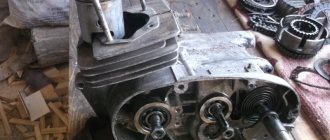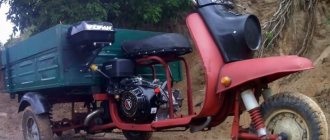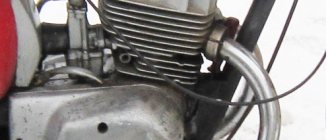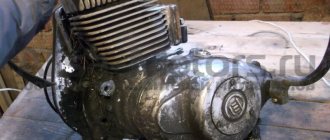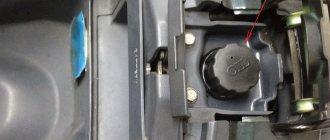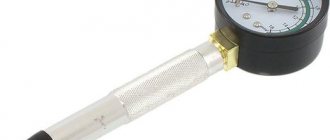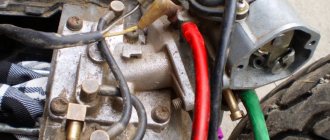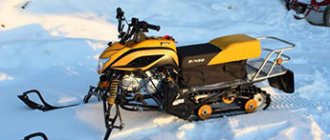The peculiarity of Chinese scooters is that, regardless of the manufacturer, they are equipped with the same engines. The most common is the 4T engine 139QMB (available in 50cc, 60cc, 70cc, and 80cc versions) and its older brother 157QMJ (150cc and 170cc). If your scooter is equipped with a 139QMB engine, you can easily install a CPG with a displacement ranging from 50cc to 80cc. With the 157QMJ engine, things are somewhat more complicated, and to install 170cc instead of 150cc, you will have to grind the crankcase.
Separately, it is worth noting Chinese two-stroke engines for scooters. The two copies of the legendary Yamaha 3KJ two-stroke differ from the original in having a 12mm diameter piston pin and a thicker crankshaft. Chinese two-strokes are marked 1E40QMB and 1E50QMB. They differ from each other in working volume. The younger 140QMB has a displacement from 50 to 70cc, the older 150QMB has a displacement from 70 to 100 cubic centimeters.
We will consider more powerful cubic capacity engines in a separate article.
Cylinder-piston group.
Finally, the most effective improvement for any engine is replacing the CPG. But not just a replacement, but the installation of a new, larger piston. Fortunately, there are now many ready-made kits on the market; you don’t have to sharpen or adjust anything, as with Soviet equipment. Moreover, there is even a lot to choose from. For example, for various models with a volume of 50 cubic meters, they offer kits to increase to 63, 72, 82 and even 90+ cubic cm. In some cases, this is an almost double increase in power.
The situation is similar with larger engines, for example, for 125 cubic meters, sets of 150 or 170 cubic meters are sold. Some, in the process of tuning a scooter, manage to increase 150 cubic meters with their own hands to 225 cubic meters. Choosing the right part is not the most difficult thing, the most difficult thing is installing it. After all, this process involves almost complete disassembly of the engine. You will be faced with the need to have several special removable keys in your arsenal; you can ask them from friends or borrow them for the evening at auto repair shops. We strongly recommend studying the technical component in order to properly disassemble, replace the necessary elements and assemble the motor.
Alas, for some, increased power does not promise anything other than breakdowns or inadequate performance. This is because by significantly increasing power, you inevitably entail work on all other nodes. Let's imagine that we installed a new 92 cc CPG on an old 50 cc engine. The first thing to check is the condition of the connecting rod, crankshaft and bearings. Otherwise, they will fly first, followed by our new system of both cylinder and piston.
Great, we added new bearings to the CPG, an elbow with a connecting rod, now we can be sure of reliability. But the engine does not go faster, and we decide to purchase a new carburetor. Now the mixture is too rich, and we understand that the exhaust needs to be changed. After such modifications, the engine sounds loud, accelerates perfectly, but the maximum speed is slightly higher than before and the variator sounds strange. After installing a high-speed CVT, for example from the Italian manufacturer Polini, the engine will be able to fully realize its new power. The last stage is an inspection of the brake system; you don’t want to find out at a speed of 60 km/h that the brakes are now comparable to bicycle ones.
As a result, after replacing almost all the components, we got a very fast “flea” that can surprise your friends and experts in this technology. Over time, you can make changes to the chassis system, replace shock absorbers, and install more attractive wheels. Often, the modernization process does not stop there, and after tuning a scooter 50, 150 with your own hands, impressive improvements in appearance are made. The moped is repainted, panels are changed, new devices, lighting, and so on appear.
Engine device
Beginning scooter riders, if they need to repair the motor, try to understand its design. Diagram 157QMJ will help you obtain information about the structure of the power unit and its components. Having dealt with it, you can not only purchase the necessary spare parts for the 157 QMJ engine, but also correctly perform the work of assembling and disassembling the engine. Structurally, the motor is practically no different from its GY6 counterpart. The 157 QMJ has the same cylinder-piston group, clutch, crankcase, camshaft and muffler.
The bearing numbers, sizes of silent blocks and gears, diameters of the variator pulleys and the design of the kickstarter, generator and electric starter also correspond. The engine is cooled by the oncoming air flow. Starting is carried out from an electric starter or kickstarter. Torque is transmitted through a variator, which is an automatic integral transmission.
Depending on the design features of the scooter on which the engine is installed, it can be equipped with a CVT having an extended box. The engine is equipped with a standard power system, providing fuel consumption reduced to 2.5-3 liters per hundred. The power unit operates quite quietly, providing almost silent acceleration of the scooter during maneuvers.
The motor is equipped with a standard power supply system
Characteristics and tuning of the QMJ 157 engine
Various two-stroke and four-stroke engines are used to power Chinese scooters. The most popular are four-stroke motorcycles, which include the QMJ 157 power unit. Engine capacity is 9.2 liters. With. has one 150cc cylinder and is copied from the Japanese GY6 Honda engine model. The drive from the motor to the drive wheel is carried out through a variator included in the delivery package of the engine. Wanting to increase the speed that a motorcycle or scooter develops, they often perform engine tuning.
Audi
- Audi A1 (8X) (04.2015 - 10.2018) 1.4 TFSI - Audi A1 (8X) sportback (04.2015 - 10.2018) 1.4 TFSI - Audi A3 (8V) (04.2015 - present) 1.4 TFSI - Audi A3 (8V)back sport (04.2015 - present) 1.4 TFSI - Audi A3 (8V) sedan (04.2015 - present) 1.4 TFSI - Audi A3 (8V) cabriolet (04.2014 - present) 1.4 TFSI
SEAT
— SEAT Leon 3 (5F) (05.2015 — 08.2018) 1.4 TSI — SEAT Leon 3 (5F) SC (05.2015 — 08.2018) 1.4 TSI — SEAT Leon 3 (5F) ST (05.2015 — 08.2018) 1.4 TSI — SEAT Toledo 4 (NH ) (05.2015 - 04.2019) 1.4 TSI
Skoda
— Skoda Fabia 3 (NJ) (02.2018 — present) 1.4 TSI R5 — Skoda Rapid (NH) (05.2015 — present) 1.4 TSI — Skoda Rapid (NH) spaceback (05.2015 — present) 1.4 TSI - Skoda Superb 3 (3V) (04.2015 - present) 1.4 TSI - Skoda Superb 3 (3V) combi (04.2015 - present) 1.4 TSI - Skoda Yeti (5L) (05.2015 - 12.2017) 1.4 TSI - Skoda Kodiaq (NS) (10.2016 - present) 1.4 TSI
Volkswagen (Volkswagen)
— VW Polo Sedan (61) (05.2016 — present) 1.4 TSI — VW Golf 6 (5K) cabriolet (05.2015 — 05.2016) 1.4 TSI — VW Golf 7 (5G) (05.2015 — present) 1.4 TSI — VW Golf 7 (5G) variant (05.2015 - present) 1.4 TSI - VW Golf Sportsvan (05.2015 - present) 1.4 TSI - VW Jetta 6 (1B) (05.2015 - present) 1.4 TSI - VW Passat B8 (3G) 1.4 TSI (05.2015 - present) - VW Passat B8 (3G) variant (05.2015 - present) 1.4 TSI - VW Scirocco (05.2015 - 11.2017) 1.4 TSI - VW Tiguan 2 (AD/ BT) (01.2016 - present) 1.4 TSI
Malfunctions
The main disadvantage of the X20D1 and X25D1 engines is rightly called rapid wear due to improper or excessive use. To carry out repair work on these internal combustion engines, you must have extensive experience and specific technical knowledge in the field of modern engine building. Almost all malfunctions of these motors are associated with accidents or wear. The first can be prevented, the second is in no way possible, because it is an irreversible process that occurs sooner or later.
Indeed, there are only a few real masters of these engines in Russia. Whether this is due to the fact that Epika has never been a bestseller in our country or the motor is simply structurally complex is unknown. Therefore, many owners of cars equipped with these units are faced with the question: how to find a suitable replacement, because repairs may not yield anything worthwhile.
About the knock
Engine knocking is noticed more often on a 2-liter unit with a manual transmission. And on Epic, in 98 cases out of 100, this leads to rotation of the liners on the second cylinder. The oil pump jams because the lubricant is produced, loses its original properties, and a lot of excess soot or chips form inside the pump. The oil pump stops due to the fact that it begins to rotate tightly in such a situation, because it is of a rotary type. Both gears quickly overheat and expand.
The oil pump on the Epica is connected directly to the timing chain. Due to problems with the pump (stiff rotation), there is a large load on the gears associated with the crankshaft. As a result, the pressure disappears, and the oil on this engine reaches the second cylinder last. Here is the explanation of what is happening.
For this reason, if the bearings on the engine have turned, you should change the oil pump and rings at the same time. There is also an original way that makes it possible to get rid of the repetition of such a situation. It is necessary to carry out modernization - to modify the timing pump-gear chain.
- Secure the oil pump gear and timing gear together.
- Center both sprockets.
- Drill a hole with a diameter of 2 mm so as to insert the needle bearing from the Zhiguli crosspiece inside. First, you need to saw off a pin of the required size from the bearing, then insert it as a retainer. A strong piece of hardened metal will hold both gears securely.
Engine markings for Chinese scooters! Let's sort it out piece by piece.
Each motor of “rice” scooters has its own marking, which encodes the features of a particular unit. During scheduled scooter repairs (or unscheduled ones), many owners encounter some difficulties in finding spare parts, because they search for the main parts by the model name and not the engine marking. To do this, I recommend that you carefully examine the scooter’s engine, and after washing it of oil and dirt, find engraved numbers and Latin letters there. Most often, the location of these inscriptions is in two places:
- on the crankcase, underneath the cover, in the area of the front variator
- engraving in the gearbox area, also located on the engine crankcase.
Quite often I see how on forums and thematic groups on social networks, fans of the Chinese motorcycle industry argue that, for example, 152QMI and 157QMJ are different engines in principle. Let's figure out what all these numbers and letters mean. The first digit “ 1 ” ( 1 39QMB) in the marking will indicate that the engine has 1 cylinder. If you suddenly see the number “2” - go nuts, the scooter’s engine is two-cylinder. The letter “P” (1P39QMB) indicates that the cylinder is in a horizontal position. If the letter “P” is missing, then the cylinder on the scooter is not necessarily horizontal. So 139QMB and 1P39QMB, whatever one may say, are the same engines. The next two digits in the designation are “39”, “ 52 ”, etc. (1 52 QMI) denote the internal diameter of the cylinder liner, and accordingly the diameter of the piston and rings in the piston group. The first letter speaks about the scooter’s cooling system: “F” (139FMB, 1P39FMB) - air cooling of the motor occurs by free flow;
“Q” (139QMB, 152QMI, 157QMJ) - forced air cooling, there is a blower casing on the cylinder. If the letter is missing, the engine is most likely water-cooled (172MM - CH250). The second letter is the engine type: “M” (139QMA, 139FMA) - motorcycle engine. The third letter in the marking corresponds to the working volume of the cylinder-piston group of the scooter: “A” - up to 50 cubic meters (139QMA) - “honest” fifty dollars); “B” - up to 70 cubic meters (139QMB) - the most common, “almost honest” half-shock, which according to the rules should be labeled as 147QMB or even 150QMB;
"G" - up to 100 cubes; “H” - from 100 to 125 cubes (a rare variety of the GY6 family);
“I” - from 120 to 130 cubic meters (152OMI);
“J” - from 150 to 155 cubic meters (157QMJ);
“L” - up to 200 cm3;
“M” - up to 250 cc (172MM) - Chinese dropsy clone of Honda Spacy / Freeway with CH 250 engine. Engines of the ARN family are also often found, with markings such as 153QMI, 157QMJ-H, 158QMI. Such engines are installed on Keeway and Stels scooters. They are often confused with the GY6 152QMI and 157QMJ family, both in the cylinder-piston group and in the cylinder head and all other parts of the engine. Although they are visually similar (152qmi-153qmi and 157qmj-158qmj), when purchasing spare parts it is worth checking these details with the seller. Concluding the “debriefing” on the dispute about 152QMI and 157QMJ, I would like to add on my own behalf that the engine data differs only in the cylinder displacement (52.4 mm and 57.4 mm). And such engines can also be called 1P52QM and 1P57QMJ.
Clutch
Everyone knows about the clutch problems with this engine.
I wrote above that the engine tends to stall at low speeds under load. This is also a known issue.
To prevent the engine from stalling, you need to work with the clutch lever and gas.
The problem is that here you have to keep the speed higher so that the engine does not stall, but in this case the clutch heats up much more and wears out.
When heated, the clutch stops disengaging completely and because of this it heats up and wears out even more. Burning discs is quite easy.
Interestingly, there are a lot of comments on the Internet about the absence of problems with the clutch, but also a lot about problems. For example, a topic on the website china-moto.ru.
Guys, the clutch on the 177 engine is burning, this is the third time this spring. Where to look?
I thought about springs, put washers under the bolts, but it still burned out.
The first and last friction discs are in normal condition, but those between them are burning.
Motorcycle racer, exploitation for all the money, but friends have nothing on their bikes. I buy Liqui Moly 10w-40 oil at the company store. I drove it in the fall, no problems.
Over the winter I installed a bigbor and replaced the carb with an FCR37. Maybe this has something to do with the matter.
I change the clutch as a kit, so crooked discs have nothing to do with it, I put in the OTOM green clutch, which seems to be reinforced.
Same problem as you. Just train harder and that’s the end of it.
I didn’t take the motorcycle for light rides on level ground. The original clutch lasted 60 hours. I bought a replacement and it was done in literally 20 hours.
I must say it was winter, I tried to “break through” through the deep crust and simply fired. Now I have a supply of disks, but they are eaten up very quickly.
And the most annoying thing is that I can’t train in something I’m not very good at (lifting the front wheel in the right place and to the right height).
Maybe stronger springs will help? They say the squeeze after them is heavy. But you can, for example, put 2 instead of 6.
Various options are described on the Internet on how to fix this problem or at least extend the life of the clutch. Most likely they will help, but this is not certain.
Head, piston, crankshaft
The question immediately arises: why is the head with a single camshaft installed? Because the engine is positioned as a sports one.
Already in the 90s they came to the conclusion that for high-speed engines it is optimal to install two camshafts.
Firstly, with two camshafts, the spark plug is installed clearly in the center and the flame front spreads more correctly.
Secondly, the camshaft cams interact directly with the valves, which is good when operating at high speeds.
Thirdly, more flexible adjustment of valve timing is possible.
If I’m not mistaken, in 2021 information appeared on the Internet that this engine with a twin-shaft head was being tested, and even on Aliexpress I saw such a head for sale.
Since then, nothing has been known about those tests. Motorcycles are still sold with a single shaft head.

